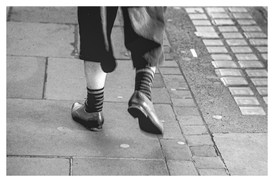The Art of Black and White Photography: A Guide for Beginners
- Janusz Miarka
- Mar 14
- 3 min read
The allure of black and white photography lies in its simplicity and profound expressive power. Stripping away the distraction of colour, black and white images challenge photographers to think differently about light, shades, and textures. This post aims to educate novice photographers and potential clients about the timeless art of black and white photography, from its historical significance to modern digital techniques.
Images by Janusz Miarka
History of Black and White Photography
Black and white photography has a rich history, beginning with the first daguerreotypes in the 1830s. These early images marked the advent of photographic technology, capturing moments with a stark realism that was previously unattainable. As the medium evolved, black and white photography became a crucial tool for documenting history and culture, influencing everything from journalism to fine art. The absence of colour forces viewers to focus on the subject and composition, making each frame a study in contrast, light, and shadow.
image_1 by Ansel Adamsa image_2 by Henri Cartier-Bressona image_3 by Sebastiao Salgado
Technical Aspects
Understanding light and shadow is crucial in black and white photography. Light affects the tones and contrast of an image, influencing its mood and emotional impact. When selecting equipment, consider cameras and lenses that offer robust monochrome modes or, for purists, traditional film cameras. The development process, whether in a darkroom or through digital software, allows photographers to manipulate these elements to enhance the image’s aesthetic and emotional appeal.

Composition and Aesthetics
Effective black and white photography relies on the use of lines, shapes, textures, and contrast. These elements help create dynamic images that are visually engaging. Photographers must learn to visualize in monochrome, thinking about how the interplay of light and dark shapes the scene before them. Mastering tonal variations—from deep blacks to bright whites—is essential to producing striking images that evoke a sense of depth.
Emotion and Narrative
Black and white images are powerful tools for storytelling. Without colour, photographers must find new ways to convey emotions and narratives through composition, texture, and contrast. This form of photography often evokes a sense of nostalgia and timeless beauty, making it effective for portraying intense emotions and dramatic scenes.
Black and white portraits of the residents of Sexax by Janusz Miarka
Influential Figures and Iconic Images
Photographers like Ansel Adams, Henri Cartier-Bresson, Sebastiao Salgado and Dorothea Lange have defined the potential of black and white photography. Their work demonstrates the power of this medium to capture the essence of a moment or the soul of a subject. Studying their photographs provides valuable lessons in composition, light, and emotional depth.
Black and White Photography Across Genres
Whether in portraiture, landscapes, photojournalism, or street art, black and white photography remains versatile and impactful. It offers unique perspectives in each genre, emphasizing forms and stories that might be overlooked in colour.
Challenges and Opportunities
Working with black and white can be challenging due to the limitations of greyscale. However, these challenges often spur creativity, pushing photographers to explore new angles and techniques. Modern digital tools have also expanded the possibilities for black and white imagery, making it more accessible and versatile than ever.
Contemporary Tools and Techniques
Digital technology has transformed black and white photography. Advanced editing software allows photographers to manipulate light, shadow, and grain with precision, blending traditional aesthetics with modern techniques. Comparing analog and digital methods provides insights into how the medium has evolved while maintaining its core principles.

Practical Workshops and Exercises
For those eager to delve into black and white photography, consider practical projects like capturing the same scene at different times of the day to observe changes in light and shadow. Experiment with various subjects to see how monochrome affects the perception of each.
Black and White in Contemporary Art
In today's art world, black and white photography holds a revered place, often associated with sophistication and timeless elegance. Its future in the digital age looks promising, with ongoing innovations that continue to push the boundaries of what can be achieved.
Conclusion
Black and white photography is not just about capturing light and shadow but about capturing feelings and stories. It teaches us to see the world differently, focusing on the essence of what we observe.
Learn More
For more insights into photography and art, visit my section – Frames of Knowledge
#PhotoMiarka #JanuszMiarka #BlackAndWhitePhotography #LearnPhotography #PhotographyBasics #ArtOfMonochrome #ClassicPhotography #PhotoEducation #VisualStorytelling #TimelessArt






















Comments